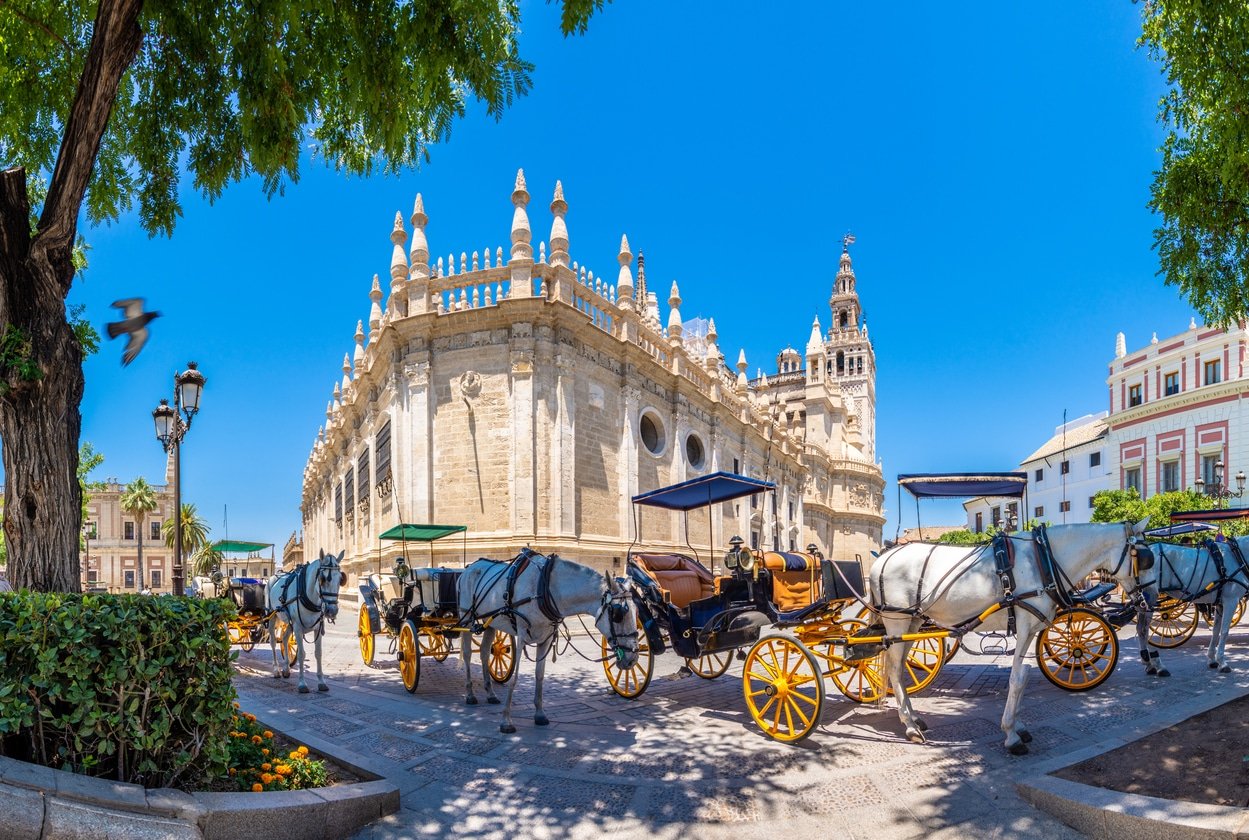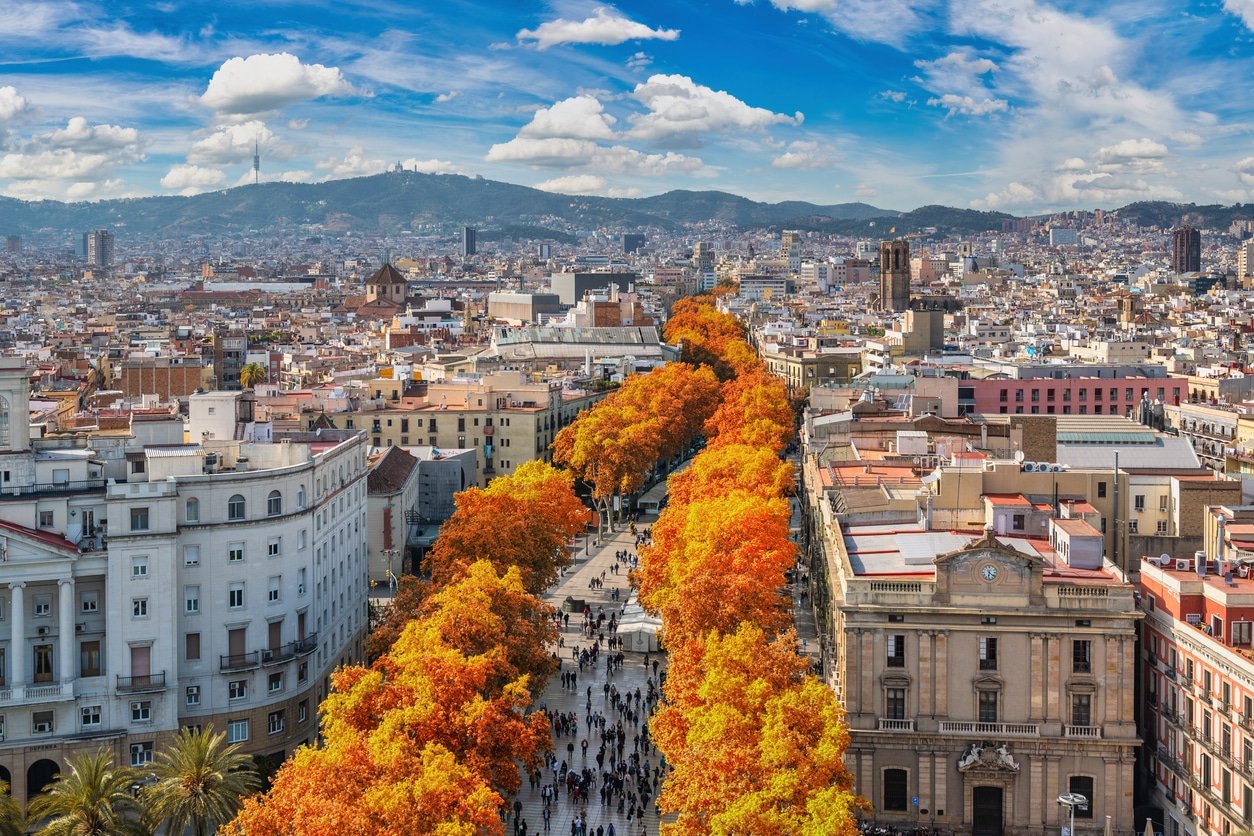Seville or Madrid: An Honest Comparison To Help You Choose!
|
Prefer listening over reading? We got you covered!
Getting your Trinity Audio player ready...
|
If you’re hoping to have a sunny Spanish adventure, Madrid and Seville are two of the best destinations to choose. With warm weather, fabulous food, and plenty to see and do, these cities can appeal to travelers of all ages.
However, since they’re situated quite far apart, in totally different regions, seeing both Seville and Madrid on the same trip isn’t always easy. You may only have time to visit one, so which should you choose?
Well, given that Seville and Madrid are very different cities in terms of their vibe, weather, location, and activities, the choice should be quite an easy one to make…
Seville is much further south, with hotter temperatures, easier access to the beach, and quieter vibes all-round.
Madrid, as the Spanish capital, is far bigger and busier, with amazing landmarks, fascinating museums, and a convenient, central location with terrific transport links.
Of course, there are many other ways in which Madrid and Seville differ, but luckily our honest guide will highlight them all!
Below, we’ll look at how Madrid and Seville compare in food, attractions, day trips, affordability, and more, giving you all the info you need to make the right choice. Let’s get started!
CONTENTS:
- A Quick Overview
- Which Is Best For Activities?
- Which Is Better For Day Trips?
- Which Is Better For Nightlife?
- Which Is Best For Shopping?
- Which Has The Best Food?
- Which Is Better For A Family Trip?
- Which Is Better For Couples?
- Which Is Better For Backpackers?
- Which Is Cheaper?
- Where To Stay According To Your Budget
- Which Has Better Weather?
- Which Is The Better Choice?
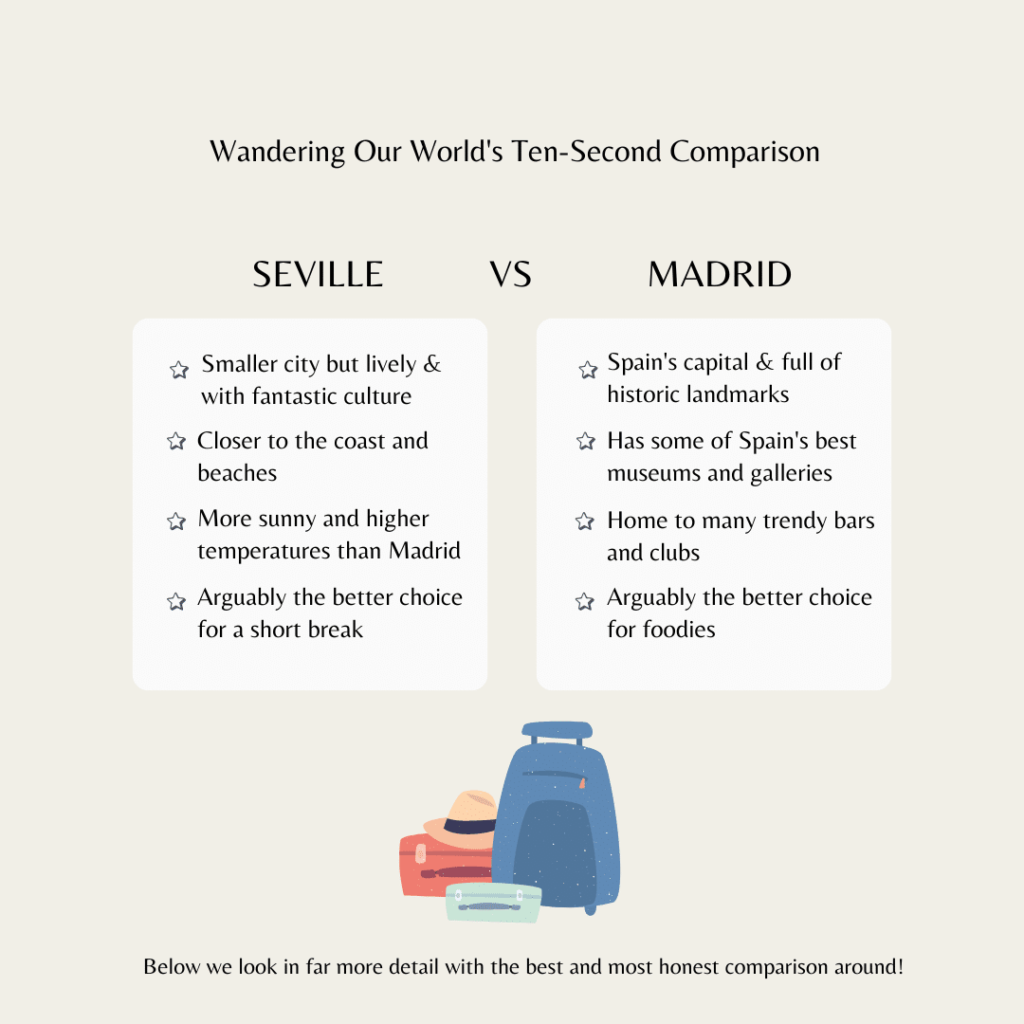
A Quick Overview: Madrid vs Seville
Madrid: A Quick Overview
Madrid is the capital city of Spain and is also the country’s largest city, with a population of around 3.6 million in the city itself and over 6.7 million in the full metropolitan area.
In other words, it’s a very busy, hustling, bustling place with lots of live, and it’s situated in the center of the country, alongside the River Manzanares.
Various peoples have lived on the land that makes up Madrid, from the Ancient Romans to the Celts. However, the city as we know it today only first started to be formed in the 9th century.
Medieval Islamic settlers built a fortress in the area, before Christians drove them out and then continued to expand on their early foundations.
Nowadays, Madrid is not only Spain’s capital, but also the country’s leading economic and political, with huge influence both domestically and internationally in fields like fashion, art, science, and culture.
It’s also one of the country’s most-visited destinations, but still has the looks and feel of a major working city, rather than a pure and simple touristic destination.
Travelers to Madrid are often impressed by the city’s bustling streets and majestic architecture, with many palaces and grand structures from the past being wonderfully well-preserved.
This city is also one of the museum and art gallery capitals of Spain, while also boasting many other attractions, like vast plazas and parks, live music and sporting events, and world-class dining.

Seville: A Quick Overview
Seville, or Sevilla, is the fourth-largest city in Spain. However, it’s significantly smaller than Madrid, with a city population of 700,000 and a metropolitan population around 1.5 million.
Thanks to this, it feels a lot quieter and calmer than Madrid. It’s located in the southern Andalusia region, not far from the coast.
This city’s history dates way back to the days of the Roman Empire. It was originally called Hispalis when Romans founded it, approximately 2,200 years ago.
Like many other cities in this part of Spain, it fell under Islamic rule during the 8th century, and it was those settlers who built some of Seville’s most beautiful buildings, like the iconic Alcazar Royal Palace.
In the centuries after that, Seville continued to expand, becoming the main urban hub for all of Andalusia.
It’s the largest city in the south of Spain and often cited as the center of Andalusian culture, cuisine, and tradition, with many famous festivities taking place in this city, like Flamenco dance events and the biggest Holy Week processions in the country.
When compared to Madrid, Seville is much more of a tourist location, attracting lots of visitors from around the world, with its historic landmarks and numerous high quality hotels.
It’s a great gateway or starting point for exploring Spain’s southern regions, while also offering plenty of charming museums and other attractions of its own.
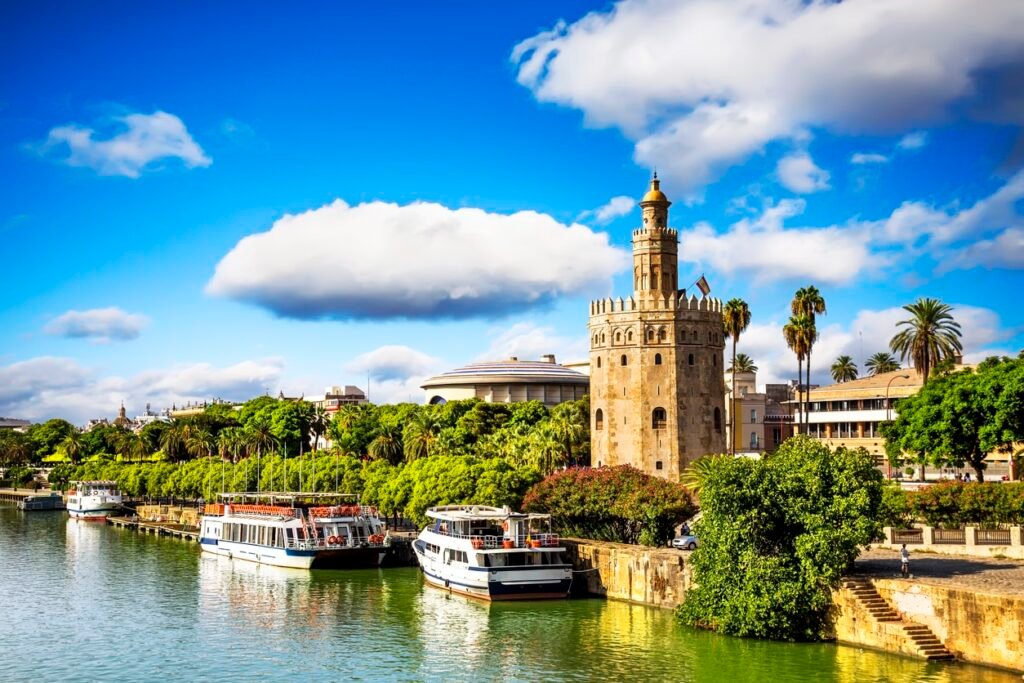
Which Is Best For Activities?
Before deciding on which city to visit, it’s wise to look at the various activities and attractions on offer. This can help you plan out your itinerary and decide on all the things you might like to see and do.
It can also help you choose between two big cities, like Madrid and Seville, as they have some notable differences in terms of their main attractions…
Madrid: The Activities
As the capital and cultural heart of Spain, Madrid is one of the best cities to visit if you want to learn about this nation’s unique culture and history.
There are tons of museums in Madrid, along with amazing galleries. The Prado Museum is a must-see, or you can head to the Reina Sofia to see Picasso’s legendary “Guernica”.
Madrid’s extensive art collection continues at the Thyssen-Bornemisza, home to works from the great artistic masters of the past, like Dali and Picasso.
Or, if history is more your style, check out the National Archaeological Museum, with displays and artifacts dating back to the days of Ancient Greece and Rome.
Outside the galleries and museums, Madrid also boasts a long list of beautiful buildings and historic landmarks.
There’s the Royal Palace, which is usually open to public tours and serves as the official residence for the Spanish royals, as well as the super selfie spot of Plaza Mayor and intriguing Temple of Debod.
If you want to soak up some of Madrid’s famous sunshine, you can also spend time exploring the city’s big parks, like El Retiro, home to more than 15,000 trees.
Or, you can enjoy some of the capital’s excellent entertainment, including bullfights, theater, live music shows, and football games with some of the world’s greatest players at the Santiago Bernabeu Stadium.

Seville: The Activities
While Madrid may be a terrific destination for museums and galleries, Seville is more oriented around sightseeing and history.
The city’s rich past means that there are lots of interesting buildings, historic landmarks, and well-preserved structures still standing after all these centuries, and visitors will find lots of lovely sights simply roaming the city streets.
The most famous landmark in Seville has to be the Alcazar Palace. It’s one of the finest examples of Mudejar architecture in all of Spain, blending elements of Islamic architecture with Renaissance and Gothic aspects.
There are some gorgeous gardens surrounding the palace, too, and it’s no surprise that this place has been a popular filming location for TV shows and films.
Beyond the Alcazar, Seville has many more striking and impressive buildings to discover. There’s the huge Seville Cathedral, which houses the tomb of famed explorer, Christopher Columbus, along with the awe-inspiring General Archive of the Indies, the Royal Tobacco Factory, and multiple tall towers dating back to medieval times.
Seville’s parks may be smaller than those of Madrid, but it still has several nice green spaces to enjoy the warm weather, like the Parque Maria Luisa and the Parque de Miraflores, which is a nice spot for jogging or playing with kids.
Or, to cool off, head into one of the city’s museums, like the Flamenco Art Museum or fascinating Bullfighting Museum.
Overall, in terms of quantity, Madrid wins this clash. It has more things to do, and you’ll need a couple of extra days to really appreciate the full depth of the capital.
Seville is smaller and simpler, but it’s a goldmine for lovers of history, flamenco dancing and architecture, and well-suited to short city breaks of just two or three days.

Which Is Better For Day Trips?
If you’re planning to do a day trip or two from Madrid, you’ll have a lot of options to choose from. There are numerous high-speed train services leaving the capital daily, and you might be surprised to see how far you can travel in just a few hours, opening up many different day trip destinations.
Madrid is only half an hour away from charming and historic Toledo, for example. The fairy tale city of Segovia is also very easy to access, or you could head out to the coastal city of Valencia for a day at the beach.
If you’re feeling ambitious and can get up early enough, there are high-speed trains to take you to Barcelona in under three hours.
Seville is another excellent city to base yourself for day trip adventures. And it’s perfectly-placed for exploring the southern cities.
You can head to the coastal party city of Malaga, for example, or visit gorgeous Huelva, with its whitewashed buildings. Jerez is another super city to see, renowned for its wonderful sherry and old Moorish fort.
Overall, both of these cities give you plenty of day trip options to choose from.
Madrid is probably a little better, simply due to its amazing transport network and central location, but Seville is a great gateway to the south. Plus, it’s much closer to the coast for those who want to spend time at the beach.
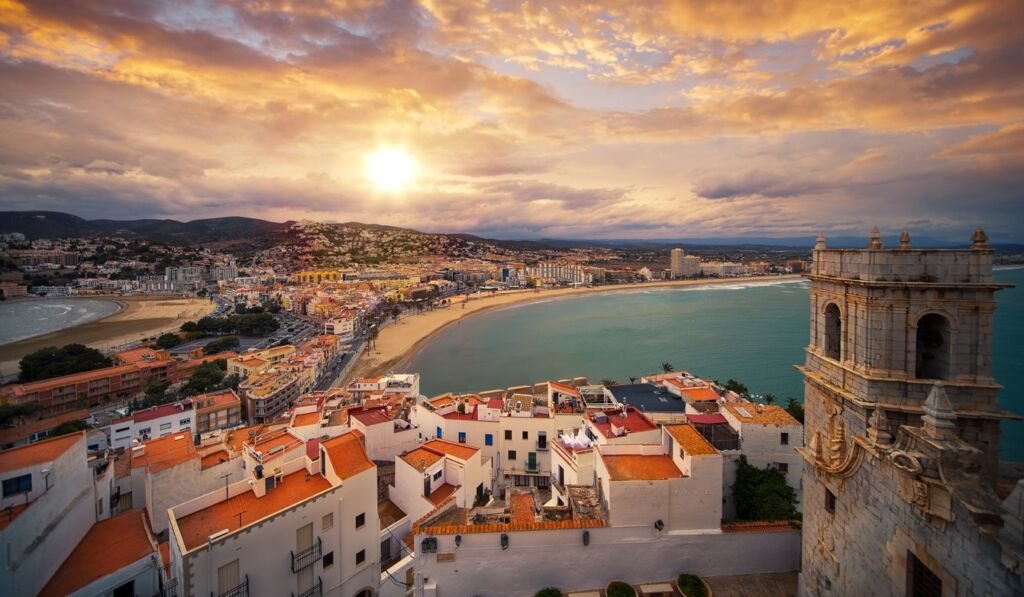
Which Is Better For Nightlife?
Spanish people love to party, and all of the country’s big cities have plenty of bars, clubs, live entertainment venues, and other fun places to spend time in the evenings, all the way through to the early hours.
So, no matter whether you visit Madrid or Seville, you shouldn’t have a hard time finding places to drink, dance, and mingle.
However, there is still a difference. As the much larger city, Madrid has a wider range of clubs and nightlife hotspots, and its clubs and bars tend to be bigger and more crowded with locals and travelers from around the globe.
You can find trendy bars galore and all sorts of thumping themed clubs in places like Lavapiés and Barrio de Salamanca.
Seville’s nightlife scene is a little smaller, but still just as rowdy as Madrid’s. It’s a big student city, so many of the main clubs in places like Alfalfa and La Alameda tend to get busy with young people, partying through until 5 or 6 in the morning.
There are some really exciting, hardcore dance clubs in Seville, too, perfect for people who love staying out late.
Overall, Madrid’s nightlife is a little better and more diverse, but you can have a super time in the evenings in either one of these cities.

Which Is Best For Shopping?
For shopaholics, Madrid is right up there alongside Milan, London, and Paris as one of the top cities to shop in the whole of Europe.
Since it’s such a vast city, you can find street after street, lined with stores and boutiques selling absolutely everything, from books to homeware, fashion, jewelry, accessories, toys, and so much more.
Stretching for almost a full mile, the Calle Gran Via, or Spanish Broadway, is one of the best places to shop.
It’s got lots of big brand fashion boutiques, along with massive department stores, like El Corte Ingles. Malls like the Plaza Rio 2 are also great places to spend an afternoon, while Madrid also has fantastic markets, like San Miguel and Santa Ana.
In Seville, you can also find plenty of luxury stores, designer brands, and long shopping streets.
The Calle Tetuan and Calle Asuncion streets house many of the big European brands, while Calle Sierpes has enough stores to keep you busy for several hours. The Mercado de Feria is a great place to grab fresh, local produce, too.
Overall, it’s Madrid that takes the win in this category. Seville can be fun for souvenir shopping, and it’s less crowded, so it may be easier to browse some of the stores.
But Madrid simply has way more options, from antique emporiums to massive malls, lively markets, and upmarket boutiques.

Which Has The Best Food?
Spain has some of the most flavorful food in all of Europe, with ideal conditions for growing lots of fresh fruits and veggies, along with excellent seafood straight from the Mediterranean and historic, iconic recipes, like paella.
But which city will tantalize your taste buds the most, between Seville and Madrid?
Well, once again, it’s Madrid that edges ahead in this department. Thanks to its massive size and global city status, Madrid has one of the biggest and most diverse collections of restaurants in all of Spain.
You can taste all the best dishes from various Spanish regions here, in addition to foods from other parts of Europe, Asia, and beyond.
In Seville, the food scene is a little more typical and traditional, with lots of tapas bars and regional dishes on the menu.
Naturally, as the biggest city in Andalusia, Seville is a great place to taste local specialties, like gazpacho soup and fried seafood. It’s also ideal for people who want to bounce from bar to bar, snacking on tapas and sampling fine southern wines.
Overall, with more diversity and depth, Madrid’s culinary scene is better than Seville’s, and arguably better than any other Spanish city, too.
Still, if you like tapas, you won’t have any complaints about Seville’s cuisine.

Which Is Better For A Family Trip?
Heading to Spain with children? If so, both Madrid and Seville can appeal to you, but you may find that one city is a little better for your family, depending on the ages of your children and the kinds of activities you all enjoy the most.
Madrid has quite a lot of family attractions. There’s the Parque de Atracciones de Madrid theme park, for example, with wild rollercoasters and rides, along with the massive Zoo Aquarium and the fantastic Parque Warner.
This theme park is inspired by American culture and characters, with kids able to meet the likes of Scooby-Doo and the Looney Tunes.
While Madrid has much to offer young children, Seville is a little less kid-friendly. There are some play areas and parks for picnics and games, and children can also have fun climbing the unique Setas de Sevilla giant mushroom structures.
However, little ones might be a little bored by the city’s historic buildings and museums.
Overall, we think Madrid is the better choice for most families, especially those with younger children.
Older kids and teens will also appreciate the livelier nature of Madrid, as well as its museums, shops, and restaurants. If you have kids who love history, Seville is still a top choice.
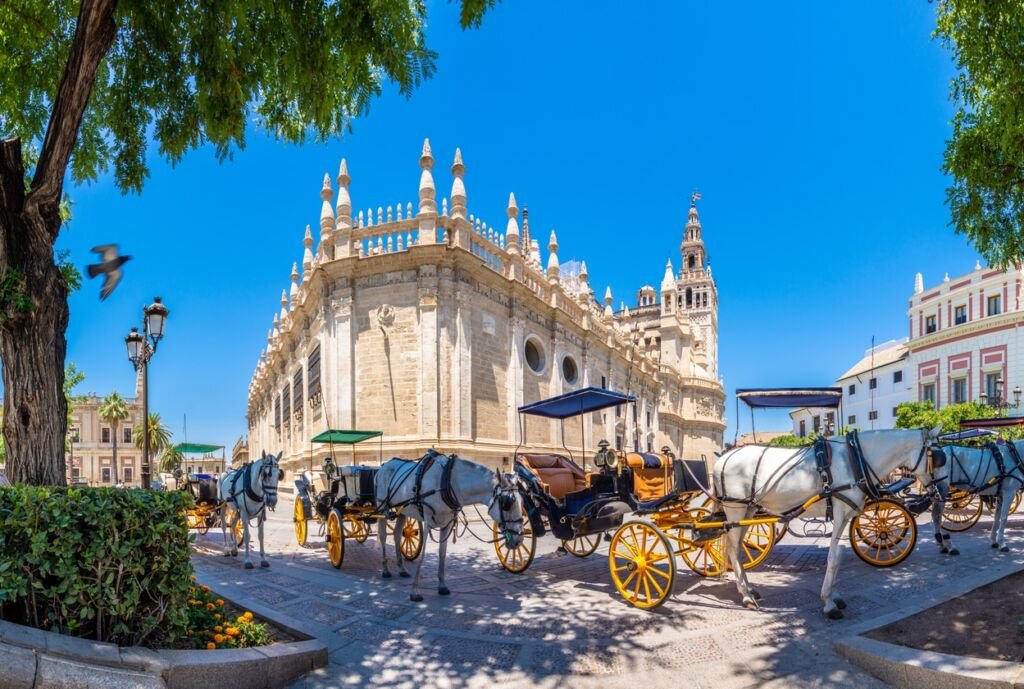
Which Is Better For Couples?
For couples, the choice between Madrid and Seville will mainly depend on what kinds of activities and experiences you’re looking for.
In terms of pure romance and scenic beauty, Seville is arguably the better city for couples. It’s a gorgeous place, with historic treasures around every corner and so many lovely landmarks to admire.
Plus, with more sunshine and warmth than Madrid, you’ll have plenty of time to walk around, hand-in-hand with your partner, soaking up the sun and admiring the views all around.
Madrid is a beautiful city, too, but its crowded and somewhat chaotic nature might overwhelm some couples.
However, if you’re looking for an action-packed trip, with plenty to see and do each day, this is an idyllic destination. It’s also got the best food in Spain, perfect for those long, romantic dinners with your special someone.

Which Is Better For Backpackers?
For backpackers, budget is usually the main thing to take into account. And if you’re looking for the cheapest of the two cities, Seville is the one to choose.
It has numerous low-cost hostels to keep you safe and warm at night, and the tapas bars tend to be very cheap and accessible for all. Plus, most of the landmarks are bunched up together, so it’s easy to get around and see everything.
Much larger and more expansive, Madrid takes more time to see and costs more money, too.
With that said, it’s still quite easy to have a great backpacking adventure in Madrid, as there are lots of hostels around the center and plenty of cheap street food and low-cost bars to visit. There are lots of free things to do in the capital, too, and great transport links to other cities.
Overall, backpackers can have a good time in either city. Seville is super for history buffs and those who want to spend the least, but Madrid is easier to access, with more to see and do.

Which Is Cheaper?
Finally, we have to discuss the average costs and see which city is more affordable.
In general, southern Spain tends to be cheaper than the north, so you can expect to spend less if you visit Seville instead of Madrid.
Everything from food to hotels is cheaper in Seville, and there’s little need for public transport, since the city is quite compact.
In contrast, you’ll most likely have to spend some cash to get around in the capital, as well as spending a few extra euros on food and hotels, too.
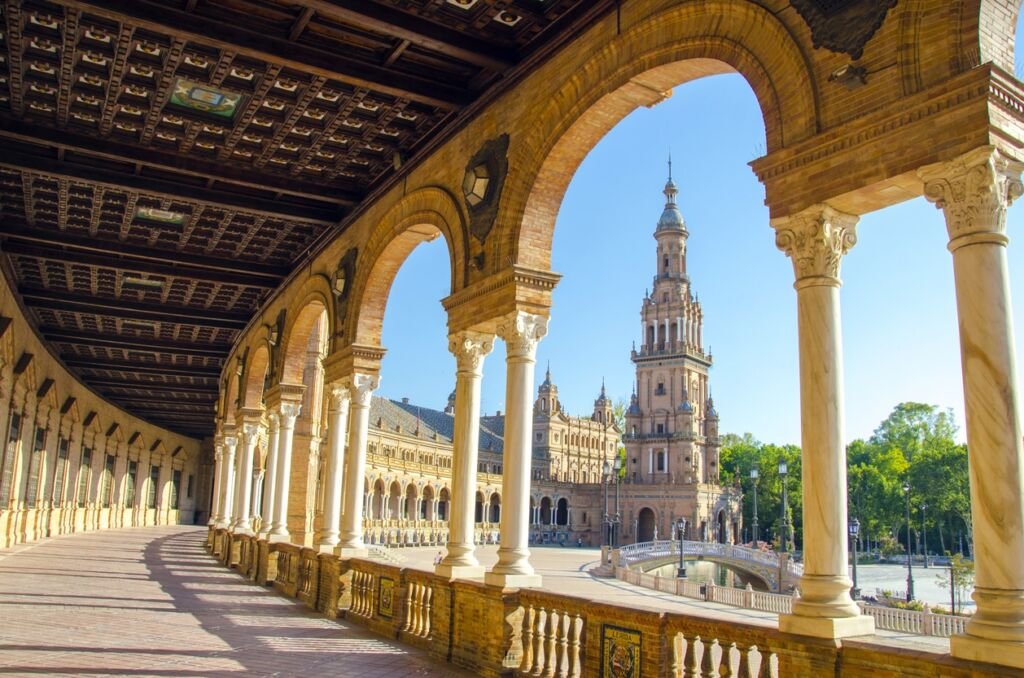
Where To Stay According To Your Budget
Madrid
Budget: Stay Inn Madrid is home to a wonderful, modern, clean apartment with balcony set in the middle of Madrid. That central location means you’re close to all the main attractions, yet for a fraction of the price of other accommodation choices close by. See photos and rates!
Luxury: For a luxurious stay in Spain’s capital, you can’t beat Gran Hotel Inglés. This gorgeous five-star hotel is known for its world-class service, exceptional decor, great food and superb city location. See photos and rates!
Seville
Budget: Set in a 16th century building, Hotel Posada del Lucero is located directly in the city’s old town and despite its very reasonable prices, it comes with gorgeous decor, fantastic service and even an outdoor pool. See photos and rates!
Luxury: With world-class service and a gorgeous outdoor pool, Hotel Alfonso XIII is a luxury stay in one of Spain’s most prestigious hotels. The rooms are photogenic and classy, while the location is perfect. See photos and rates!

Which Has The Best Weather?
Spain is one of Europe’s most popular vacation destinations, partly because of its weather. It sees lots of sunshine, with plenty of warm days to enjoy throughout the summer and in the shoulder months, like May and September.
However, since Madrid and Seville are quite far apart, their weather conditions are notably different.
Naturally, since Seville is the furthest south of the two cities, it gets the highest temperatures. In fact, summer highs in Seville can approach 97°F (36°C). Spring and fall are generally warm and comfortable in Seville, and even in winter, the temperature doesn’t go too low.
Madrid isn’t as hot as Seville, but it’s still a warm and sunny destination for summer fun, with highs of 92°F (33°C) and very low chances of rain for most of the year.
Overall, both cities can feel sweltering in the peak months of July and August, and the heat might be too much for some. So you may prefer to visit just before the summer begins, or for early fall.
But those who love intense heat and sunshine will adore Seville, with Madrid being a little milder and more comfortable.

Madrid or Seville: Which Is The Better Choice?
Overall, Madrid and Seville are both beautiful, exciting destinations to explore, with some clear and obvious differences.
The capital is much larger and more dynamic, with endless museums, stores, and restaurants, while the southern city is a historic haven, filled with beautiful remnants of days gone by.
In terms of the best city to visit, Madrid is probably the right choice for most travelers, especially first-timers in Spain.
It’s a magical city, offering some of the best Spanish dining, shopping, and cultural experiences, all in one place. Plus, with such terrific transport links, it’s so easy to get to and ideal for exploring other cities and regions.
With that said, Seville still has some unique advantages and shouldn’t be ignored or overlooked. It’s a very pretty and scenic city, perfect for couples and fans of history.
And if you’re looking to immerse yourself in all things Andalusian, like flamenco dancing and top-notch tapas, Seville is a great city to visit.


